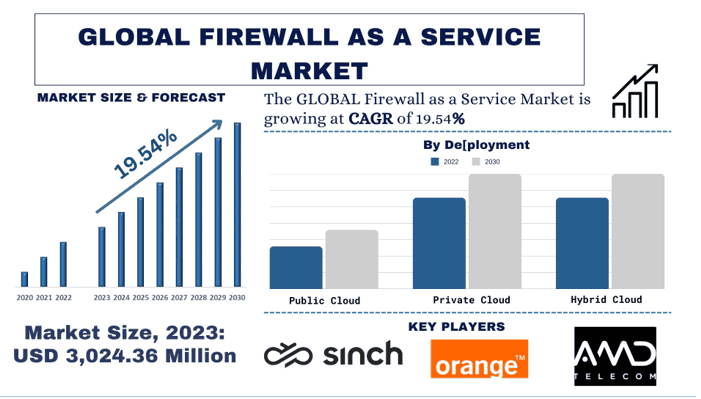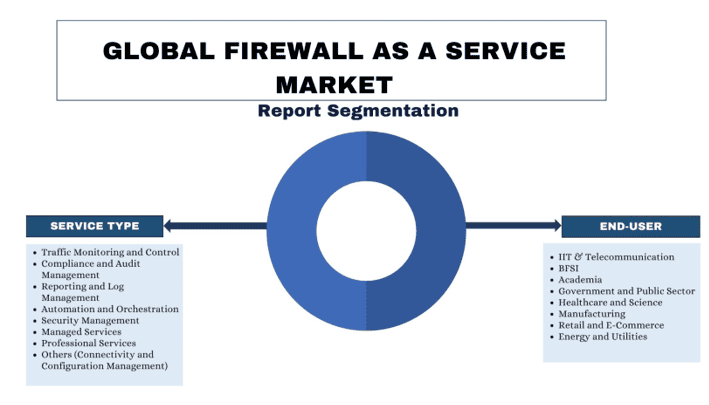- Home
- About Us
- Industry
- Services
- Reading
- Contact Us
Firewall as a Service Market: Current Analysis and Forecast (2024-2032)
Emphasis on Service Type (Traffic Monitoring and Control, Compliance and Audit Management, Reporting and Log Management, Automation and Orchestration, Security Management, Managed Services, Professional Services, and Others); Service Model (Infrastructure As A Service (IaaS), Platform As A Service (PaaS), and Software As A Service (SaaS)); Deployment (Public Cloud, Private Cloud, and Hybrid Cloud); End-Users (IT & Telecommunication, BFSI, Government and Public Sectors, Healthcare and Science, Manufacturing, Retail and E-Commerce, and Energy And Utilities); and Region/Country

Firewall As A Service Market Size & Forecast
The firewall as a service market was valued at USD 3,024.36 Million and is expected to grow at a strong CAGR of around 19.54% during the forecast period (2024-2032) owing to the growing cyber security threats.
Firewall As A Service Market Analysis
Firewall as a Service (FWaaS) is a cloud-based firewall solution that helps simplify IT infrastructure for companies. It provides next-generation firewall capabilities like web filtering, advanced threat protection, intrusion prevention systems, and Domain Name System security. Essentially, FWaaS delivers firewall protection through a cloud-based service model, offering companies the benefits of security without the need for physical hardware on-site. This service is designed to enhance network security by monitoring and controlling incoming and outgoing data traffic based on established security rules, helping to prevent unauthorized access and protect against potential threats.
The proliferation of cloud computing has led to a paradigm shift in how businesses operate and manage their IT infrastructure. FWaaS provides seamless integration with various cloud platforms, ensuring consistent security policies across hybrid and multi-cloud environments. Moreover, the COVID-19 pandemic has accelerated the adoption of remote work. With employees accessing corporate resources from multiple devices and locations, traditional on-premises firewalls struggle to provide comprehensive protection. FWaaS offers a centralized security solution that can enforce consistent policies and protect remote workers, regardless of their location or device. Additionally, in today’s rapidly evolving business landscape, organizations require agility and the ability to scale their operations quickly. FWaaS solutions offer on-demand scalability, allowing businesses to easily adjust their security resources based on changing requirements. Furthermore, the cybersecurity industry is facing a significant shortage of skilled professionals, making it challenging for organizations to build and maintain in-house security teams. For instance, according to the (ISC)² Cybersecurity Workforce Study 2022, the global cybersecurity workforce gap has increased to 3.4 million, up from 2.7 million in 2021. These developments along with others are fostering a conducive environment, influencing the widespread adoption of firewalls as a service across various industries.
Firewall As A Service Market Trends
This section discusses the key market trends that are influencing the various segments of the Firewall As A Service Market as identified by our team of research experts.
The Banking, Financial, & Insurance (BFSI) sector stands out as a major end-user segment for the Firewall As A Service Industry worldwide.
The Banking, Financial Services, and Insurance (BFSI) sector is the major end-user for firewalls as a service in the global market. The BFSI industry is subject to strict regulations and compliance requirements to safeguard sensitive financial data and transactions. Firewalls play a crucial role in meeting these regulatory standards. Furthermore, financial institutions handle vast amounts of sensitive data and monetary transactions, making them attractive targets for cybercriminals. Network firewalls act as the first line of defense against various cyber threats. Moreover, The BFSI sector is considered critical infrastructure, and any disruption or breach can have severe consequences for the economy and public trust. Network firewalls help protect this critical infrastructure by controlling and monitoring network traffic. Additionally, the BFSI industry is undergoing rapid digital transformation, with the adoption of online banking, mobile applications, and cloud-based services. As these digital channels expand, the attack surface also increases, necessitating robust network security. Factors such as these have made the BFSI industry a major end-user segment for firewalls as a service across the world.

North America Emerges as the Largest Market for Firewall As A Services Worldwide.
Within North America, the United States of America holds the major portion of the Firewall As A Service market of North America. The major factor boosting the market’s growth is its leadership position in the technology industry globally. Furthermore, the United States of America is home to some of the biggest banks in the world, fueling the need for robust security firewall infrastructure.
North America, particularly the United States, is a hub for technological innovation and cutting-edge cybersecurity solutions. Furthermore, North America boasts a robust economy with a significant number of large enterprises and businesses across various industries. These organizations have substantial IT budgets allocated for cybersecurity, including investment in network security firewalls to mitigate risks effectively. Moreover, the United States, with one of the largest digital populations globally, witnesses a significant number of cyber attacks annually. As per a survey conducted in 2021, approximately 60 percent of online users in the country encountered some form of cyber attack, placing it as the third-highest country in terms of cybercrime prevalence. In the latest reported year, incidents of data violation affected approximately 294 million internet users in the United States. Among the various types of cyber attacks, network intrusion emerged as the most prevalent across the nation, motivating the government to increase investments in cyber security strategy, benefitting the firewall as a service vendor. For instance, In FY 2024, DHS allocated over USD 3 billion to cybersecurity, making it the top-funded agency among CFO act government agencies, excluding DoD. Overall cybersecurity expenditure in the US was increased in 2023, with total agency funding estimated at USD 10.46 billion.

Firewall As A Service Industry Overview
The firewall as a service market is competitive and fragmented, with the presence of several global and international market players. The key players are adopting different growth strategies to enhance their market presence, such as partnerships, agreements, collaborations, new product launches, geographical expansions, and mergers and acquisitions. Some of the major players operating in the market are Sinch; AMD Telecom; Orange; SAP; Sophos Ltd.; Tata Communications; Telecom Italia Sparkle S.p.A; Twilio Inc.; Route Mobile; and Nokia.
Firewall As A Service Market News
- In January 2024, Zscaler Inc. launched Zscaler Zero Trust SASE, a complete secure access service edge solution, and their Zero Trust SD-WAN solution. These solutions are built on the zero-trust architecture, which prioritizes verifying all connections to a system rather than blindly trusting anything within or outside the organization’s perimeters.
- In January 2024, as per the report published by the World Economic Forum (WEF), 29% of organizations reported that they had been materially affected by a cyber incident in the past 12 months, and 41% of the organizations that suffered a material incident in the past 12 months reported that it was caused by a third party, necessitating the need for security firewalls across various industries.
Firewall As A Service Market Report Coverage

Reasons to buy this report:
- The study includes market sizing and forecasting analysis validated by authenticated key industry experts.
- The report presents a quick review of overall industry performance at one glance.
- The report covers an in-depth analysis of prominent industry peers with a primary focus on key business financials, product portfolios, expansion strategies, and recent developments.
- Detailed examination of drivers, restraints, key trends, and opportunities prevailing in the industry.
- The study comprehensively covers the market across different segments.
- Deep dive regional level analysis of the industry.
Customization Options:
The global Firewall As A Service market can further be customized as per the requirement or any other market segment. Besides this, UMI understands that you may have your own business needs, hence feel free to contact us to get a report that completely suits your requirements.
Table of Content
Research Methodology for the Firewall As A Service Market Analysis (2024-2032)
Analyzing the historical market, estimating the current market, and forecasting the future market of the global Firewall As A Service market were the three major steps undertaken to create and analyze the adoption of Firewall As A Services in major regions globally. Exhaustive secondary research was conducted to collect the historical market numbers and estimate the current market size. Secondly, to validate these insights, numerous findings and assumptions were taken into consideration. Moreover, exhaustive primary interviews were also conducted, with industry experts across the value chain of the global Firewall As A Service market. Post assumption and validation of market numbers through primary interviews, we employed a top-down/bottom-up approach to forecasting the complete market size. Thereafter, market breakdown and data triangulation methods were adopted to estimate and analyze the market size of segments and sub-segments of the industry pertains to. Detailed methodology is explained below:
Analysis of Historical Market Size
Step 1: In-Depth Study of Secondary Sources:
A detailed secondary study was conducted to obtain the historical market size of the Firewall As A Service market through company internal sources such as annual reports & financial statements, performance presentations, press releases, etc., and external sources including journals, news & articles, government publications, competitor publications, sector reports, third-party database, and other credible publications.
Step 2: Market Segmentation:
After obtaining the historical market size of the Firewall As A Service market, we conducted a detailed secondary analysis to gather historical market insights and share for different segments & sub-segments for major regions. Major segments are included in the report as service type, service model, deployment, and end-users. Further country-level analyses were conducted to evaluate the overall adoption of testing models in that region.
Step 3: Factor Analysis:
After acquiring the historical market size of different segments and sub-segments, we conducted a detailed factor analysis to estimate the current market size of the Firewall As A Service market. Further, we conducted factor analysis using dependent and independent variables such as service type, service model, deployment, and end-users of the Firewall As A Service market. A thorough analysis was conducted of demand and supply-side scenarios considering top partnerships, mergers and acquisitions, business expansion, and product launches in the Firewall As A Service market sector across the globe.
Current Market Size Estimate & Forecast
Current Market Sizing: Based on actionable insights from the above 3 steps, we arrived at the current market size, key players in the global Firewall As A Service market, and market shares of the segments. All the required percentage shares split and market breakdowns were determined using the above-mentioned secondary approach and were verified through primary interviews.
Estimation & Forecasting: For market estimation and forecast, weights were assigned to different factors including drivers & trends, restraints, and opportunities available for the stakeholders. After analyzing these factors, relevant forecasting techniques i.e., the top-down/bottom-up approach were applied to arrive at the market forecast for 2032 for different segments and sub-segments across the major markets globally. The research methodology adopted to estimate the market size encompasses:
- The industry’s market size, in terms of revenue (USD) and the adoption rate of the Firewall As A Service market across the major markets domestically
- All percentage shares, splits, and breakdowns of market segments and sub-segments
- Key players in the global Firewall As A Service market in terms of products offered. Also, the growth strategies adopted by these players to compete in the fast-growing market.
Market Size and Share Validation
Primary Research: In-depth interviews were conducted with the Key Opinion Leaders (KOLs) including Top Level Executives (CXO/VPs, Sales Head, Marketing Head, Operational Head, Regional Head, Country Head, etc.) across major regions. Primary research findings were then summarized, and statistical analysis was performed to prove the stated hypothesis. Inputs from primary research were consolidated with secondary findings, hence turning information into actionable insights.
Split of Primary Participants in Different Regions

Market Engineering
The data triangulation technique was employed to complete the overall market estimation and to arrive at precise statistical numbers for each segment and sub-segment of the global Firewall As A Service market. data was split into several segments & sub-segments after studying various parameters and trends in the areas of service type, service model, deployment, and end-users in the global Firewall As A Service market.
The main objective of the Global Firewall As A Service Market Study
The current & future market trends of the global Firewall As A Service market were pinpointed in the study. Investors can gain strategic insights to base their discretion for investments on the qualitative and quantitative analysis performed in the study. Current and future market trends determined the market’s overall attractiveness at a regional level, providing a platform for the industrial participant to exploit the untapped market to benefit from a first-mover advantage. Other quantitative goals of the studies include:
- Analyze the current and forecast market size of the Firewall As A Service market in terms of value (USD). Also, analyze the current and forecast market size of different segments and sub-segments.
- Segments in the study include areas of service type, service model, deployment, and end-users.
- Define and analyze the regulatory framework for the Firewall As A Service
- Analyze the value chain involved with the presence of various intermediaries, along with analyzing customer and competitor behaviors of the industry
- Analyze the current and forecast market size of the Firewall As A Service market for the major region
- Major countries of regions studied in the report include Asia Pacific, Europe, North America, and the Rest of the World
- Company profiles of the Firewall As A Service market and the growth strategies adopted by the market players to sustain in the fast-growing market.
- Deep dive regional level analysis of the industry
Related Reports
Customers who bought this item also bought










